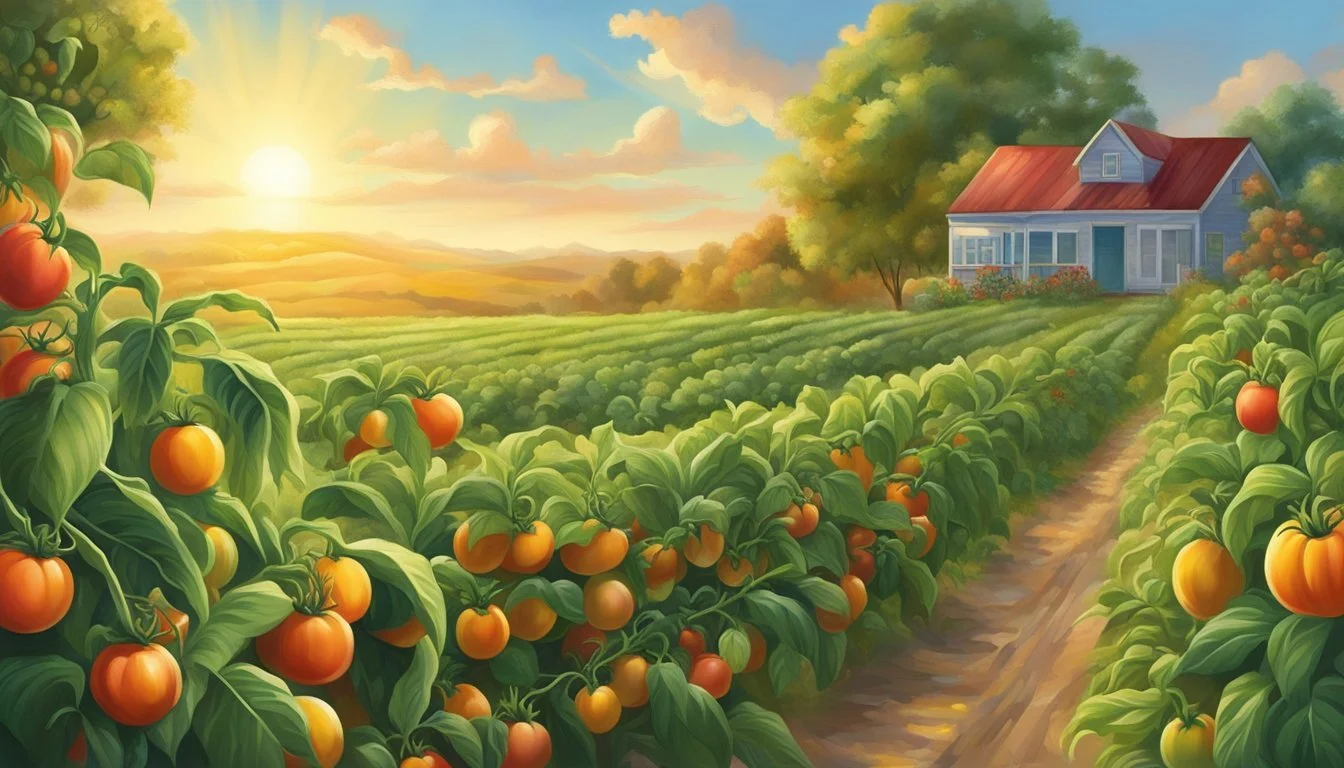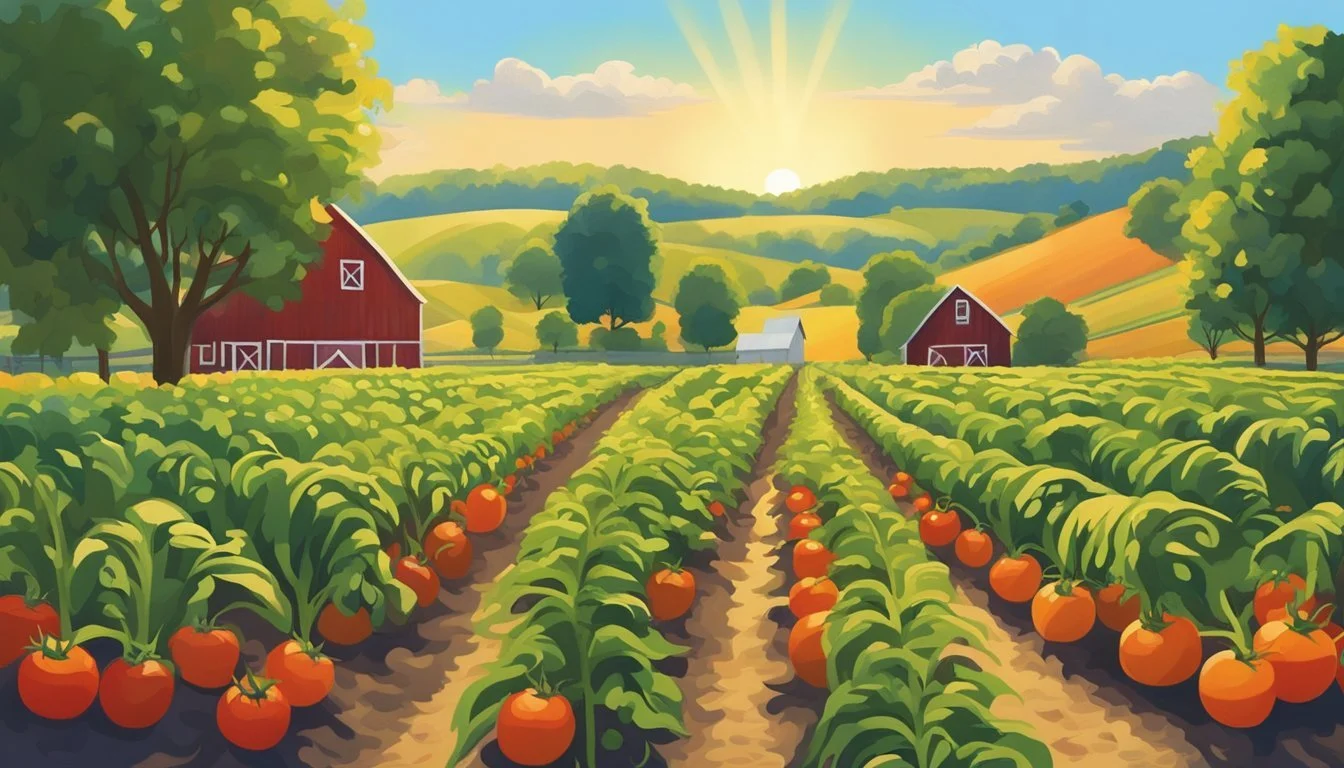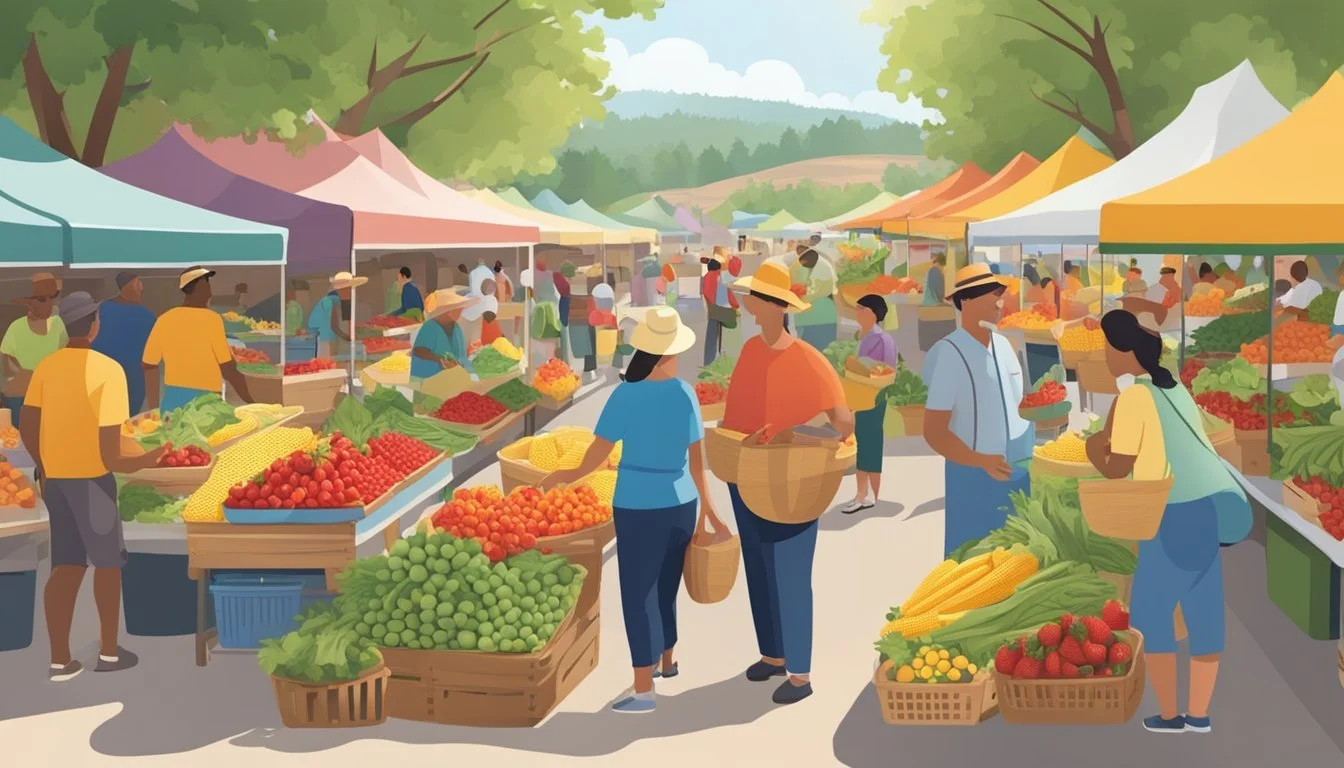Kentucky Seasonal Fruit & Vegetables in July
Your Fresh Produce Guide
This Article is Part of our Kentucky Seasonal Fruit & Veg Calendar
July in Kentucky heralds the height of summer, a time when the sun nourishes the soil and the state's farms bustle with activity. This month, local markets and gardens overflow with the bounty of the season, offering an array of fresh produce. Consumers eagerly anticipate the arrival of summer crops, which are at their peak of freshness, flavor, and nutritional value.
Kentucky's temperate climate and fertile land make it ideal for growing a variety of fruits and vegetables. In July, one can look forward to a plethora of in-season produce. The state is known for its flavorful tomatoes, crisp cucumbers (how long do cucumbers last?), and sweet corn, all of which reach their prime in the summer warmth.
In addition to these staples, July sees the ripening of several fruits. Blueberries (how long do blueberries last?), blackberries (how long do blackberries last?), and peaches, among others, become abundant. These fruits, freshly picked, not only offer a superior taste but also support local agriculture and sustainable food practices. With each visit to a local farmer's market or roadside stand, consumers can indulge in the freshness that epitomizes Kentucky's July produce season.
Kentucky's Seasonal Climate and Agriculture
Kentucky's diverse agriculture thrives through a distinct cycle of seasons, each impacting the yield and quality of its produce. In July, the state's climate plays a pivotal role in bringing crops to their peak flavor and ripeness.
The Cycle of Seasons in Kentucky
Kentucky experiences four distinct seasons: spring, summer, fall, and winter. These seasons dictate the agricultural calendar for farmers across the state. In spring, planting begins as the weather warms. The summer months, including July, are crucial for growth and development of crops, leading to fall harvests. Winter is generally a period of lower activity in the fields, but planning for the next cycle occurs.
Spring: Preparation and planting
Summer: Growth and maintenance
Fall: Harvest and market
Winter: Planning and resting fields
Impact of July Weather on Crop Yield
July in Kentucky brings the peak of summer with its warm weather, which is essential for the maturation of many crops. Farmers depend on July's consistent warm temperatures to ensure crops like sweet corn reach full ripeness. The weather, often a mix of hot days and occasional rain, boosts crop yields and is a critical factor for a successful harvest. However, extreme weather, such as droughts or excessive rainfall, can challenge farmers and affect crop outcomes.
In summary, July's summer weather is vital for Kentucky farmers to achieve a bountiful harvest, especially for summer produce that reaches its peak flavor during this month.
July's Seasonal Fruits in Kentucky
In July, Kentucky celebrates the peak of summer with an abundance of sweet and flavorful fruits, especially stone fruits and various berries that thrive in the warm climate.
Stone Fruits and Berries
Peaches: These juicy fruits are at their prime in July, offering a sweet and tangy flavor that is perfect for pies, jams, or eating fresh from the orchard.
Cherries (how long do cherries last?): By July, cherries have ripened to their fullest, with both sweet and sour varieties available for picking, ensuring a burst of flavor in every bite.
Plums: With a delightful balance of sweet and tart, plums come into season, adding a vibrant taste and color to the summer fruit palette of Kentucky.
Berries:
Blueberries: They are a summer staple, known for their deep blue hue and sweet, yet subtly tart flavor, making them a favorite for desserts or as a fresh snack.
Blackberries: Abundant in July, these berries are known for their deep, rich flavor and are commonly used in Kentucky for pies, jams, or eaten by the handful.
Raspberries: They offer a unique and intense sweetness, making them popular among Kentuckians for their versatility in both sweet and savory dishes.
Strawberries: While the peak season is in the spring, there can still be late harvests of strawberries in early July, cherished for their classic sweet flavor.
Melons and Tropical Tastes
Watermelon: A symbol of Kentucky summers, watermelons reach their peak sweetness in July, becoming a centerpiece at picnics and barbecues.
Cantaloupe (how long does cantaloupe last?): With its soft, orange flesh, the cantaloupe is another melon that ripens beautifully in July, known for its refreshingly sweet taste.
Mango:
Although not traditionally grown in Kentucky, imported mangos can be found in markets, offering a tropical flair with their rich, sweet, and creamy flesh.
July's Seasonal Vegetables in Kentucky
July offers an abundance of fresh vegetables in Kentucky, with the peak season bringing a variety of nightshades and cucurbits along with robust leafy greens and root vegetables.
Nightshades and Cucurbits
Nightshades such as tomatoes and peppers are in full swing during July. Kentucky's warm climate allows these vegetables to thrive, presenting a prime time for harvest. Tomatoes range from heirloom varieties to the standard beefsteak, and peppers vary from sweet bells to the more piquant jalapeños.
Tomatoes: Beefsteak, Cherry, Heirloom
Peppers: Bell, Jalapeño, Banana
Cucurbits such as cucumbers, zucchini, and summer squash also enjoy the warm July weather. These vegetables are versatile in the kitchen, perfect for both fresh summer salads and cooked dishes.
Cucumbers: Slicing, Pickling
Zucchini & Summer Squash: Crookneck, Pattypan
Leafy Greens and Roots
Leafy greens are surprisingly resilient in the July heat, with lettuce, kale, and spinach (What wine goes well with spinach?) being key staples in Kentucky gardens. These greens are excellent for salads and provide a nutritious base for a variety of dishes.
Lettuce: Romaine, Butterhead, Iceberg
Kale: Curly, Lacinato
Spinach: Baby, Smooth-leaf
Root vegetables like radishes and beets can still be found in July, although they are typically sown earlier in the year. They provide a crisp, earthy element to summer meals.
Radishes: Cherry Belle, French Breakfast
Beets: Red, Golden
Farm-to-Table: Purchasing and Enjoying Local Produce
In July, Kentuckians have the advantage of accessing an array of fresh produce straight from local farms, offering a ripe opportunity for farm-to-table practices. This means enjoying seasonal fruits and vegetables at their peak of freshness and flavor.
Farmers' Markets and Direct Sales
Farmer's markets in Kentucky burst with life during the summer season, especially in July when the produce selection is abundant. Shoppers can find fresh sweet corn, ripe tomatoes, crisp cucumbers, and an assortment of berries. Not only does buying from these markets promote local farmers, but it also ensures that consumers are cooking with the freshest ingredients possible. Additionally, direct sales from farms often provide a more personal buying experience. Here is an example of what might be available at a Kentucky farmers' market in July:
Tomatoes: Ideal for salads, sandwiches, and salsas.
Sweet Corn: A summertime favorite, perfect for grilling or boiling.
Berries (Strawberries, Blueberries, Blackberries): Great for desserts or as a snack.
Green Beans: Fresh beans are versatile for cooking, canning, or freezing.
Community Supported Agriculture
Community Supported Agriculture (CSA) programs in Kentucky allow community members to 'subscribe' to the bounty of local farms. In July, these subscriptions often include a variety of fresh produce which members can incorporate into their daily meals. CSA programs help reduce food waste by harvesting only what is needed for subscribers, promoting a deeper connection between consumers and the farms that feed them. They aid in mitigating hunger by providing a steady source of nutritious food items to the community. Storing the weekly CSA haul properly is key to maintaining the freshness of fruits and vegetables such as leafy greens and root vegetables.
Recipes and Preparation
July heralds the peak of freshness for many fruits and vegetables in Kentucky. Utilizing these seasonal crops in recipes ensures vibrant flavor and nutrition.
Refreshing Summer Salads
Salads offer a crisp and cool escape from the summer heat. They maximize the freshness of seasonal greens like lettuce, kale, and spinach which are at their peak in July. Accompanied by cucumbers and tomatoes, salads become a refreshing dish. One can simply toss these ingredients with a light vinaigrette or layer them with herbs such as basil or mint for a flavorful mix. For a sweet twist, incorporating blueberries or strawberries adds a summery note.
Spinach and Berry Salad
Baby spinach
Sliced strawberries
Blueberries
Feta cheese
Balsamic vinaigrette
Classic Cucumber-Tomato Salad
Sliced cucumbers
Cherry tomatoes
Olive oil and vinegar dressing
Fresh dill
Savory and Sweet Desserts
The warmth of summer is ideal for showcasing stone fruits and berries in desserts. Baked dishes, like peach cobbler or blueberry pie, allow for the natural sugars to caramelize, enhancing their sweetness. For a lighter option, desserts can also take the form of chilled watermelon slices or strawberry parfaits with layers of homemade whipped cream. Additionally, fruits can be pickled or incorporated into chilled desserts for an unexpected savory twist, providing a palate-refreshing taste.
Kentucky Peach Cobbler
Fresh sliced peaches
Cinnamon and nutmeg
Butter and flour crust
Blueberry Lemon Tart
Fresh blueberries
Lemon curd filling
Graham cracker or pastry crust
Using these recipes as a guide, one can effortlessly integrate the abundance of July's produce into their cooking and delight in the season's best offerings.
Healthy Eating and Nutrition
July in Kentucky brings a bounty of ripe, fresh produce that can be a cornerstone of healthy eating. The state's summer fruits and vegetables are not only bursting with flavor but also packed with essential vitamins and minerals.
Vitamins and Minerals in Seasonal Produce
Kentucky's summer harvest offers an array of fruits and vegetables rich in nutrition. Blueberries, for instance, are laden with antioxidants and vitamin C. Sweet corn, available between July and September, provides essential B vitamins and fiber. Eating seasonally ensures that one benefits from the peak nutritional content of these produce items, as they are harvested at their most ripe.
Fruits and Vegetables High in Nutrients Available in July:
Blueberries: Vitamin C, Vitamin K, Manganese, Antioxidants
Sweet Corn: Vitamin B1, B5, B9, Fiber
Diet and Weight Management
Incorporating fresh, in-season produce such as fruit and vegetables into one's diet supports weight management. High fiber content, particularly from vegetables like bell peppers, contributes to satiety, which can help manage hunger and thereby aid in maintaining a healthy weight. Salads made with a variety of leafy greens and colorful vegetables provide a nutritious meal option that's low in calories but high in fiber and hydration, perfect for summer's heat.
Examples of Low-Calorie, High-Fiber Produce for Salads:
Leafy Greens: Low in calories, high in fiber
Bell Peppers: Vitamin C, antioxidants
Consuming these seasonal foods not only elevates the flavor of a diet but also its nutritional value, supporting overall health and well-being.
Preserving Kentucky's Bounty
As July ushers in a wealth of fresh produce in Kentucky, preserving techniques such as canning, pickling, freezing, and drying become essential for extending the shelf life of fruits and vegetables. These methods not only help capture the peak flavor of the season's harvest but also allow for enjoyment of local produce throughout the year.
Canning and Pickling
Canning is a tried-and-true method for preserving tomatoes, cucumbers, peppers, and other vegetables. Proper canning involves:
Sterilizing jars and lids to eliminate contaminants.
Packing fresh produce into jars, sometimes with added salt, sugar, or spices.
Processing in a water bath or pressure canner to ensure a seal and prevent spoilage.
Pickling goes hand-in-hand with canning, especially for cucumbers to make pickles. Other vegetables like summer squash, peppers, and even certain fruits can be pickled to enhance their flavors and longevity.
Freezing and Drying
Freezing is one of the simplest ways to preserve blueberries and other fruits without significantly altering their taste or nutritional value. Key steps include:
Cleaning and preparing fresh produce by removing stems and pits.
Blanching vegetables like green beans to retain color and nutrients.
Packing produce in airtight containers or freezer bags and labeling with the date.
Drying, or dehydrating, remains a viable option for preserving fruits and some vegetables. Tomatoes can be sun-dried or dried in a dehydrator and stored for use in cooking throughout the year.
Both methods aim to inhibit bacterial growth and maintain quality, so that the luscious flavors of summer can be savored regardless of the season.
Supporting Kentucky's Agricultural Economy
Kentucky's agricultural sector thrives on the synergy of local consumer choices and supportive state-led initiatives. These components play a pivotal role in bolstering the state's economy, ensuring the sustainability of farms, and addressing hunger through agricultural development.
The Role of Consumer Choices
Consumers in Kentucky can bolster the local economy and agricultural sector by opting for seasonal produce. The decision to purchase fruits such as the 'Redhaven' peaches in July directly impacts farmers, helping reduce time-to-market and ensuring the freshness of goods. Prioritizing local produce not only supports Kentucky farmers but also contributes to reducing food transport emissions, thereby cementing consumer choices as a key factor in the state's agricultural prosperity.
Agricultural Policies and Initiatives
The state's commitment to agricultural development is evidenced by policies and strategic partnerships. For instance, Kentucky's collaboration with the USDA under the Resilient Food Systems Infrastructure Program (RFSI) is a testament to the state's dedication. More than $7 million has been allocated in competitive grant funding to reinforce the food systems infrastructure. This initiative, along with others, propels Kentucky's agriculture forward, particularly in challenging economic climates as seen in the decreased agricultural cash receipts from $8.3 billion in 2022 to $8.1 billion in 2023. Policymaking focused on stabilizing input costs and providing financial assistance underlines the state's proactive stance on supporting its farmers and the wider economy.






